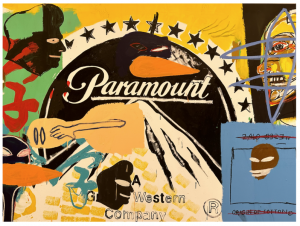
Untitled, Jean-Michel Basquiat and Andy Warhol, Photo Credit: On view at the Brant Foundation in the
East Village.
In the 1980s, Basquiat and Warhol, two iconic New York City artists that defined the
contemporary art scene during the late 20th century, collaborated on a series of works
that were exhibited. Now, these works are back in the city again as a part of a traveling
show from the Fondation Louis Vuitton in Paris, France.
The works themselves are extremely thought provoking, as Warhol’s signature silk
screen technique that prints various logos and newspaper headlines is then effaced by
Basquiat’s free-flowing, graffiti art style. One can’t help but wonder what the actual
process of their collaboration was, especially as one of the pieces appeared to have
Warhol’s artistic contributions rendered upside down, suggesting that they worked from
opposite ends of the canvas. This begs the question of which orientation is the correct
one to hang the canvas in.
The details of their thematic concerns also meshed particularly well in this collaboration.
I always conceived of Warhol as a reflector of the world around him, from the
commodification of celebrity exhibited by his copious amount of Marilyn silkscreens to
his Campbell soup cans. He was mirroring in his art the increasing hypercapitalism of
society without passing judgment. Basquiat, on the other hand, made graffiti work and
techniques into high art and frequently depicted popular Black figures as well as
examined his own identity in his works. When these ideas are combined, the
irreverence that Basquiat has for American society and the violence that he viewed as a
central tenet of industry perfectly coincides with Warhol’s silk screened icons of giant
American corporations, including General Electric and Ford. Though bright and colorful,
the message is bleak, especially as the presence of Black figures across these
paintings evoke the history of slavery in America.
A curious aspect of the exhibit is that there are no descriptions for the majority of the
displayed works. Viewers new to the collection are unaware of when exactly they were
made, what materials it is composed of, what their titles may be, and most crucially,
what the curator thinks of the piece. Consequently, it is entirely up to the viewer how
they may interpret a piece, which is continuously informed by the pieces on view before
it as visitors make their way through the exhibit from the fourth floor all the way down to
the first.
This may be intimidating for those who are unfamiliar with Basquiat and Warhol, but it
provides the opportunity for the unfettered formation of opinions about various pieces
and the merits of their collaboration. It is an occasion for pure formal analysis to take
place. For those who have already taken Art Humanities, it’s a chance to flex those
muscles again. For those who are taking it at this current moment, it’s an opportunity to
dive deeper into the works of two of the most recognized and commodified artists in the
world. I highly recommend everybody grab a friend and go
